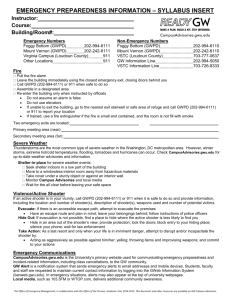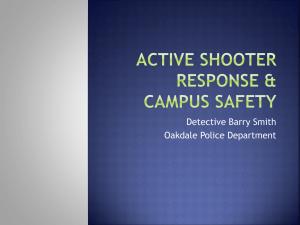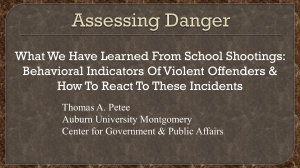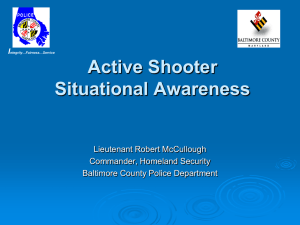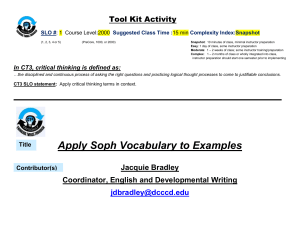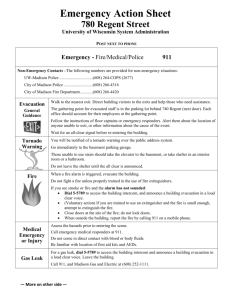Active Shooter in the Workplace - Wilmington Regional Safety and
advertisement
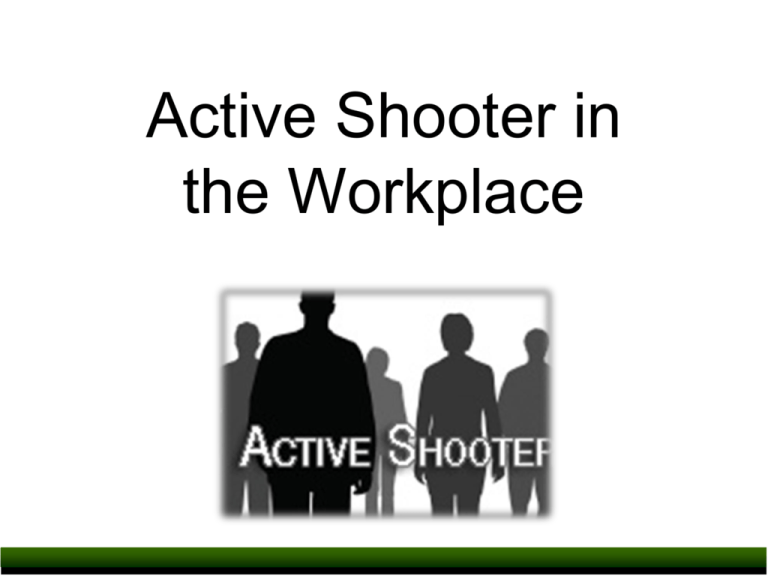
Active Shooter in the Workplace EnviroSafe Overview • • • • • Incorporated since 1996 Provides Risk Management and Crisis Management consulting services in the US, US Territories, Canada, UK, and other countries as well Passionate about regulatory compliance and comprehensive preparedness across a broad array of industries Provided Active Shooter TTX and FSE’s for all 17 of the UNC campuses Provided Active Shooter exercises within the chemical industry, healthcare industry, educational, and many others Agenda • • • • • • • What is an Active Shooter / Assailant? Can this Happen to You? Historical Data What can you do? Run – Hide – Fight APTER Overview Questions What Is An Active Shooter? An active shooter is an individual actively engaged in killing or attempting to kill people in a confined and populated area, typically through the use of firearms. As defined by US Department of Homeland Security Typical Characteristics Of An Active Shooter / Active Assailant • • • Victims are selected at random The event is unpredictable and evolves quickly Law enforcement is usually required to end an active shooter / assailant situation Can This Happen To You? Historical Incidents • Postal Incidents that occurred between 1986 and 1987…”Going Postal” • Columbine High School • Virginia Tech Mass Shootings • Aurora Colorado Theatre Shooting • Newtown Connecticut Elementary School Shooting • Fort Hood Texas What Can You Do? • • • • ALICE Model HIDE-RUN-FIGHT RUN-HIDE-FIGHT Other Methods ALICE • • • • • ALERT LOCKDOWN INFORM COUNTER EVACUATE ALERT ALERT – Can be anything Gunfire Witness Phone Alert The purpose of the ALERT is to inform as many people as possible within the danger zone that a potentially lifethreatening situation exists. This can be facilitated via many different methods (PA, text, email, personal senses). No matter the method of delivery, the objective should be a conveyance of information, not an issuance of a command. LOCKDOWN LOCKDOWN – This is a semi-secure starting point from which you will make survival decisions. If you decide not to evacuate, secure the room. Lock and barricade doors with anything and/or tie down the door using any type of strap. Turn off lights, close blinds, silence cell phones, computers, etc. Look for alternate escape routes (windows, other doors). Move out of the doorway in case gunfire comes through. Keep yourself out of sight and take adequate cover, spread out don’t huddle in groups. Try not to trap or restrict your option for movement. Once secured do not open the door for anyone. Police will enter the room when the situation is over. Call 911. • • • • • • • • INFORM INFORM – Using any means necessary to pass on real information. Given in plain language Who, what, where, when and how information. Location of shooter, number of shooters if more than one. Physical description of shooter/s. Number and type of weapons held by the shooter/s. Number of victims. Can be used by people in the area or who may come into it to make common sense decisions. Can be given in “Text Alerts”, • • • • • • • • COUNTER COUNTER – This is the use of simple, proactive techniques should you be confronted by the Active Shooter. As a last resort, and only when your life is in imminent danger, attempt to disrupt and/or incapacitate the active shooter by: • • • • • • • • • • Acting as aggressively as possible against him/her. Throwing items and improvising weapons. Anything can be a weapon. Create as much noise as possible. Attack as a group (swarm). Grab the shooters limbs and head and take them to the ground and hold them there. Fight dirty-bite, kick, scratch, gouge eyes, etc. Run around the run and create chaos. Commit to your actions. If you have control of the shooter call 911 and tell the police EVACUATE EVACUATE – Remove yourself from the danger zone as quickly as possible. • • • • • • • • • Decide if you can safely evacuate. Run in a zigzag pattern as fast as you can. Do not stop running until you are far away from the area. Bring something to throw with you in case you would encounter the Active Shooter. Consider if the fall from a window will kill you. Break out windows and attempt to quickly clear glass from the frame. Consider using belts, clothing or other items as an improvised rope to shorten the distance you would fall. Hang by your hands from the window ledge to shorten your drop. Attempt to drop into shrubs, mulch or grass to lessen the chance of injury. HIDE-RUN-FIGHT HIDE • • • • • Be out of the Active Shooter’s view. Provide protection if shots are fired in your direction. Be away from doors and windows as bullets can pass through these easily. Not trap you, or restrict your options for escape if that is possible. To prevent an Active Shooter from entering your hiding place, you should: Lock the door. Blockade the door with heavy furniture. If the Active Shooter is nearby: Lock the door. Silence your cell phone or pager. Turn off any source of noise, such as radios and televisions. Hide behind large items such as cabinets and desks. Remain quiet and ask those around you to also remain quiet. HIDE-RUN-FIGHT RUN • • • • • • • • • • • • Have an escape route and plan in your mind before you start to move. Ensure you account for all of the students, having a teacher’s aide lead the students out, while you check the last student out of the room or area. Leave your belongings behind, telling students to do the same. Break windows to escape if you are on the ground floor, clearing away glass and laying mats or clothing over the windowsill to prevent injury. You should have an adult climb out first to help students exit the window safely if this is possible. Prevent individuals from entering an area where an Active Shooter may present a threat. You should warn people to stay away without endangering yourself or your students. Keep your hands visible if police officers are outside. Follow the instructions of any police officer. Make no attempt to move wounded people. Call 911 when you are safe. Listen for special instructions over the intercom. HIDE-RUN-FIGHT FIGHT • • • • • As the very last resort, and only when your life or the lives of those around you are in imminent danger, you may decide to attempt to disrupt or incapacitate the Active Shooter by attacking or distracting them. Some options may include: Throwing items and improvising weapons such as a chair, a phone, laptop, tablet, stapler, file, book or another easily accessible object. Yelling or shouting at the aggressor in order to distract or frighten them. Seeking control of the aggressor’s hands in order to limit their ability to use a weapon. Briefing the students to escape while you are attacking or distracting the Active Shooter. RUN-HIDE-FIGHT RUN • • • Have an escape route and plan in mind Leave your belongings behind Keep your hands visible RUN-HIDE-FIGHT HIDE • • • Hide in an area out of the active shooter’s view Block entry to your hiding place and lock the doors Silence your cell phone and/or pager RUN-HIDE-FIGHT FIGHT • • • As a last resort and only when your life is in imminent danger Attempt to incapacitate the active shooter Act with physical aggression and throw items at the active shooter • • • • • Recommendations For Preparedness Threat / Vulnerability Assessments Development and(or) update of existing plans Fundamental training and provided information Periodic practice through drills or “mock exercises” Continuous improvement in plans, training, technology, facility upgrades, etc. ASSESS-PLAN-TRAIN-EXERCISE-REVISE (APTER) INDUSTRY HEALTHCARE ENTITIES ASSESS STATE RESPONSE AGENCIES CITIES REVISE THE PERPETUAL EMERGENCY PREPAREDNESS MODEL EXERCISE TRAIN PLAN FEDERAL RESPONSE AGENCIES COUNTIES ASSESSMENT • Sometimes regulatory driven (ie. PSM, RMP, CSAT, General Duty Clause) • Conduct Hazard Vulnerability Assessments (HVAs) • Utilize the team approach • Assess by department/facility • Assess based on geography • Identify your hazards and prioritize them • Hazards are your “known's” • Risks are derived from your hazards • HVAs can be done utilizing software, contractors or in-house teams • Do internal, use contractor, use insurance carrier, or a combination of more than one ASSESS PLANNING FOR EMERGENCIES • • • • • • • Emergency Action Plan (EAP) Emergency Operations Plan (EOP) Business Continuity Plan (BCP) Continuity of Operations Plan (COOP) Continuity of Government Plan (COG) Hazard Mitigation Plans Task level checklists (TLCs) PLAN PLANNING FOR EMERGENCIEScontinued In the corporate world, plans must also address risks associated financial impact, product recall, service failure, legislative/regulatory action, major executive change, data breach, etc. Plans do not always need to be thick to be effective (bullet proof) However, plans do need to be integrated into an overall Crisis Management Plan rather than in silos creating potential conflicts What you have must be tested and updated regularly Should include task level checklists (TLCs) Must be shared with community partners and employees to ensure familiarity also allowing input for continuous improvement PLAN TRAINING OPERATIONAL TRAINING • NIMS compliant Incident Command Training • ICS-100, ICS-200, ICS-300, ICS-400, ICS-700, ICS-800 • • • Communications Training Active Shooter Plan and Preparedness Training Site Specific EAP training TRAIN TRAINING-continued EXECUTIVE LEVEL TRAINING • NIMS compliant Incident Command Training • • • • ICS-402(designed for upper level management), Public Information Officer (PIO) EOC Operations (position specific) Crisis Communications TRAIN • • • • • TRAINING-continued Must be required or mandated…often times employees are required to attend yet they miss the training and never make it up LESS LECTURE AND MORE HANDS-ON (ie. filling out forms, using plans/checklists, etc.) Include community partners in your training programs Enhance training for buy in with games and incentives. Ensure training is not trying to “FEMAtize” a corporation, but rather use knowledge of all the aforementioned areas to better integrate with the national response system as well as your own response PLAN EXERCISE / DRILLS FOR EMERGENCIES • • • Tabletop Exercises (TTX) Discussion based Should implement plans and checklists Must be evaluated and strengths / weaknesses recorded – – – Functional Exercises (FE) More hands-on vs. discussion Should involve multiple departments and(or) locations Must be evaluated and strengths / weaknesses recorded – – – Full Scale Exercises (FSE) “Boots on the ground” Should involve outside agencies Must be evaluated and strengths / weaknesses recorded – – – EXERCISE EXERCISE / DRILLS FOR EMERGENCIES-continued • • • One of the most overlooked or avoided areas of the APTER™ model Exercises/Drills are most of the time conducted to meet regulatory or corporate mandates…usually not as effective as they need to be!! Usually don’t involve community partners…which are the ones that show up at your gate, invited or uninvited • Fire, EMS, EM, LE, News Media PLAN REVISE AND REPEAT • • • Say what you do…do what you say…document…practice…and revise Utilize captured information from exercise evaluations and take corrective action! Failure to take corrective action on ALL recorded deficiencies can hamper the effectiveness of your emergency preparedness!!!! REVISE Key Points • • • • • IMPLEMENT UNIFIED INCIDENT COMMAND SYSTEM…train and work with ALL employees and community partners ENSURE AN EFFECTIVE COMMUNICATIONS SYSTEM IS IN PLACE…have a communications plan, have proper equipment, practice, and be certain your communications is multi-faceted BUILD RELATIONSHIPS WITH COMMUNITY PARTNERS…Swapping business cards for the first time during a real emergency is going to cost you (injuries,job, reputation, money, embarrassment) HAVE A PLAN…develop a practical plan, communicate the plan, and have a system in place for updating the plan TRAIN AND EXERCISE….Exercises can make a real incident turn out to be minor vs. major due to relationships, pre-planning and preparedness DO SOMETHING! • • • • • • RUN-HIDE-FIGHT HIDE-RUN-FIGHT (Adopted by N School System) ALICE – Alert, Lockdown, Inform, Counter, Evacuate Plan Train Practice Questions? Steve Naylor Director of Sales and Business Development EnviroSafe Consulting
